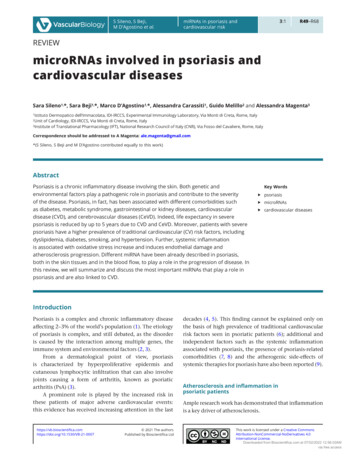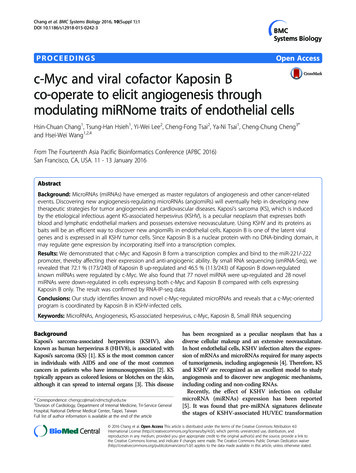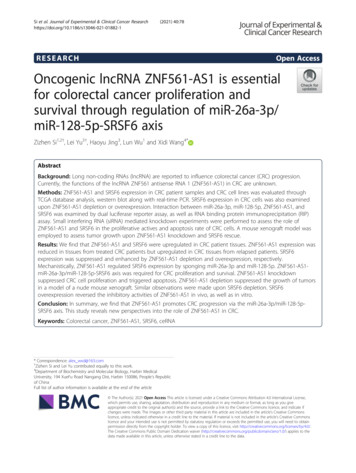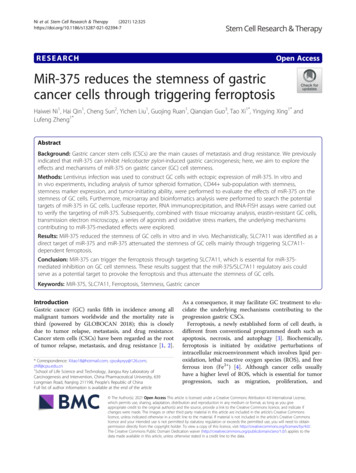
Transcription
Yang et al. Journal of Orthopaedic Surgery and (2021) 16:10RESEARCH ARTICLEOpen AccessmiR-1249-5p regulates the osteogenicdifferentiation of ADSCs by targeting PDX1Xiao-Mei Yang1, Ya-Qi Song1, Liang Li1, Dong-Ming Liu1 and Guang-Dong Chen2*AbstractBackground: Osteoporosis (OP) is an age-related systemic bone disease. MicroRNAs (miRNAs) are involved in theregulation of osteogenic differentiation. The purpose of this study was to explore the role and mechanism of miR1249-5p for promoting osteogenic differentiation of adipose-derived stem cells (ADSCs).Methods: GSE74209 dataset was retrieved from NCBI Gene Expression Omnibus (GEO) database and performedbioinformatic analyses. OP tissue and healthy control tissues were obtained and used for RT-PCR analyses. ADSCswere incubated with miR-1249-5p mimic, inhibitor and corresponding negative control (NC), alkaline phosphatase(ALP) staining, and Alizarin Red Staining (ARS) were then performed to assess the role of miR-1249-5p forosteogenesis of ADSCs. Targetscan online website and dual-luciferase reporter assay were performed to verify thatthe 3′-UTR of PDX1 mRNA is a direct target of miR-1249-5p. RT-PCR and western blot were also performed toidentify the mechanism of miR-1249-5p for osteogenesis of ADSCs.Results: A total of 170 differentially expressed miRNAs were selected, among which, 75 miRNAs weredownregulated and 95 miRNAs were upregulated. Moreover, miR-1249-5p was decreased in OP patients, whileshowed a gradual increase with the extension of induction time. miR-1249-5p mimic significantly increasedosteogenic differentiation capacity and p-PI3K and p-Akt protein levels. Luciferase activity in ADSCs co-transfectedof miR-1249-5p mimic with PDX1-WT reporter plasmids was remarkably decreased, but there was no obviouschange in miR-1249-5p mimic with PDX1-MUT reporter plasmids co-transfection group. Overexpression PDX1 couldpartially reverse the promotion effects of miR-1249-5p on osteogenesis of ADSCs.Conclusion: In conclusion, miR-1249-5p promotes osteogenic differentiation of ADSCs by targeting PDX1 throughthe PI3K/Akt signaling pathway.Keywords: miR-1249-5p, Adipose derived stem cells, Osteogenic Differentiation, PDX1BackgroundOsteoporosis (OP) is an age-related systemic bone disease characterized by reduced bone mass and, damagedbone microstructure, which eventually leads to reducedbone strength and prone to fracture [1, 2]. In addition toa significant decrease in bone mass, high levels of bonemarrow adipose tissue were also observed in patientswith annual OP [3]. Therefore, senile osteoporosis is* Correspondence: chengd2062@sina.com2The Department of Orthopedics, Cangzhou Central Hospital, No. 16 XinhuaWest Road, Cangzhou 061000, Hebei Province, ChinaFull list of author information is available at the end of the articlecharacterized by reduced bone mass in bone tissue andaccumulation of fat tissue [4].ADSCs can play the function of multidirectional differentiation and self-renewal, and can differentiate into osteoblasts,chondrocytes, adipocytes, nerve cells, and myoblasts underdifferent conditions [5, 6]. In addition, ADSCs also have theadvantages of easy access, simple sampling, minimally invasive, abundant sources, and relatively small immune rejection[7]. However, ADSCs have a low osteogenic efficiency and agreat adipogenic tendency [8]. One possible method topromote osteogenic differentiation is to use of microRNAs(miRNAs) to promote osteogenic differentiation. The Author(s). 2021 Open Access This article is licensed under a Creative Commons Attribution 4.0 International License,which permits use, sharing, adaptation, distribution and reproduction in any medium or format, as long as you giveappropriate credit to the original author(s) and the source, provide a link to the Creative Commons licence, and indicate ifchanges were made. The images or other third party material in this article are included in the article's Creative Commonslicence, unless indicated otherwise in a credit line to the material. If material is not included in the article's Creative Commonslicence and your intended use is not permitted by statutory regulation or exceeds the permitted use, you will need to obtainpermission directly from the copyright holder. To view a copy of this licence, visit http://creativecommons.org/licenses/by/4.0/.The Creative Commons Public Domain Dedication waiver ) applies to thedata made available in this article, unless otherwise stated in a credit line to the data.
Yang et al. Journal of Orthopaedic Surgery and Research(2021) 16:10MiRNAs are a class of non-coding small RNA molecules that have been shown to function by negativelyregulating target gene expression at transcriptional orpost-transcriptional levels [9]. More and more evidenceshown that miRNAs can be involved in regulatingvarious molecular biological processes, such as cellproliferation [10], differentiation [11], tissue andorgan development [12], and tumorigenesis [13].Recently, several miRNAs have been found to play animportant role in the balanced regulation of osteogenic andadipogenic differentiation. Zha et al. [14] found that miR920 promotes osteogenic differentiation of bone mesenchymal stem cells by targeting HOXA7. Feng et al. [15] foundthat miR-378 suppressed osteogenesis of bone mesenchymal stem cells via interacting Wnt/β-catenin signalingpathway. However, little is known about the role ofmiRNAs for osteogenic of ADSCs.In the present study, we downloaded and analyzedmiRNA array data in the Gene Expression Omnibus(GEO) database (https://www.ncbi.nlm.nih.gov/geo). Wefound that miR-1249-5p was differentially expressedbetween OP and healthy controls. We then performed aseries studies to explore the function of miR-1249-5pand its target gene.Material and methodsPage 2 of 10infrapatellar fat pad. Surrounding fascia and vessels werecut off and cut into 1 1 1 mm3 pieces with scissors.Then, these tissues were digested by 0.25% collagenasetype II at 37 C for 2 h. After filtration by aseptic cellsieves, the cells were washed and collected by centrifugation (500 g, 5 min, 3 ) with Hank’s. Cells fewer than 5generations old were used for experiments.The ADSCs in 6 wells plate were cultured in osteogenic differentiation medium consisted of 10% FBS, 1 10 8 M dexamethasone, 10 mM β-glycerophosphate, and50 μg/ml L-ascorbic acid.ADSCs transfectionADSCs were seeded into 6-well plate (Corning, NY,USA) for 24 h prior to transfection. miR-1249-5p mimicand miR-1249-5p inhibitor were purchased from Ribobio(Guangzhou, China), as well as the negative controls.The full-length human PDX1 coding region was clonedinto pcDNA3.1 (Invitrogen). Cell transfection of plasmids (3 μg) and oligonucleotides (100 nM) into RASFswas performed by Lipofectamine 3000 reagent (Invitrogen) according to the manufacturer’s instructions. Inrescue experiments, co-transfection was launched with1.5 μg plasmid and 60 nM miR-1249-5p mimic. Cellswere subsequently cultured for another 30 h prior tofurther study.Differentially expressed miRNAs in GSE74209The miRNA array data of 6 postmenopausal women withosteoporosis and 6 healthy postmenopausal women in theGSE74209 dataset was retrieved from NCBI Gene Expression Omnibus (GEO) database. Quantile normalization andsubsequent data processing were performed using the Rsoftware package. Differential expression analysis betweenOP and healthy control was performed using the R packagelimma. P 0.05 and fold change (FC) 1 was consideredas statistically significant. A heatmap was constructed fromthe miRNA expression data using the pheatmap R package.FunRich software is used to carry out gene enrichment analysis for differentially miRNA-targeted genes with P 0.01.OP tissue and healthy controls bone tissuesOP bone tissue was acquired from OP patients that prepared for surgery. Diagnosed criteria was in accordancewith the World Health Organizations diagnostic criteriafor osteoporosis, in which a patients T-score is less thanor equal to 2.5 (T-score 2.5) [16]. Normal bonetissue was obtained from comminuted fractures patientsthat without OP. This study was obtained from ethicsapproval by Cangzhou Central Hospital and all patientsgave consent to participate into this study.ADSCs isolation and osteogenic differentiationHuman ADSCs were isolated and cultured as previouslydescribed. In brief, adipose tissue was obtained fromALP and ARSThe ADSCs were divided into following groups: mimicNC, miR-1249-5p mimic, inhibitor NC, and miR-12495p inhibitor. All these four groups were cultured inosteogenic differentiation medium for 7 days. ALP activitywas assessed using an ALP assay kit (Beyotime, Shanghai,China).ALP staining was performed using BCIP/NBT AlkalinePhosphatase Color Development Kit (Beyotime BiotechInc., Shanghai, China). In brief, ADSCs were fixed by 4%paraformaldehyde and then incubated with BCIP/NBTworking solution for 30 min. Stained cells were observedunder microscope and were photographed.Alizarin Red S (ARS) staining (Solarbio, Beijing, China)was performed to assess the calcium deposition. In brief,ADSCs were induced for 21 days and fixed with 4%paraformaldehyde for 15 min. After washing with PBSfor 3 and then stained with 1% Alizarin Red S (Solarbio,Beijing, China) solution for 30 min. Stained cells wereobserved under Olympus microscope (Tokyo, Japan)and were photographed.Quantitative real-time PCR (qRT-PCR)Total RNA from ADSCs were extracted with QiagenmiRNeasy Mini kit (Qiagen, Hilden, Germany) followingthe manufacturer’s protocol. Then, we reverse transcribed RNA to cDNA (Takara, Dalian, China) following
Yang et al. Journal of Orthopaedic Surgery and Research(2021) 16:10the manufacturer’s instruction. Quantitative RT-PCRwas then performed by One-Step SYBR PrimeScript RTPCR Kit II (Takara, Dalian, China). The relative expressionlevels of miR-1249-5p and PDX1 mRNA were calculatedby 2 ΔΔCT methods with normalization to U6 small nuclear RNA (U6) and glyceraldehyde-3-phosphate dehydrogenase (GAPDH), respectively. All PCR reactions wereperformed in triplicate. Primers were as shown in Table 1.Western blotThe intracellular protein was collected by digestion andcentrifugation, washed twice with PBS, and the cellpellet was collected by centrifugation. A certain amountof lysate was added and lysed on ice for 30 min. Afterlysing, the total protein was collected by centrifugationat 12,000 r/min for 15 min at 4 C. A certain amount ofprotein loading buffer was added, and the mixture wasdenatured at 100 C for 15 min, and then polyacrylamidegel electrophoresis (12%, SDS-PAGE) was performed.After electrophoresis, the proteins were transferred to a4.5-μm polyvinylidene fluoride (PVDF) membrane. ThePVDF membrane was blocked with 5% non-fat milk for1 h at room temperature, and a primary antibody ALP(Abcam, 1:1000), OSX (Abcam, 1:1000), AKT (Abcam,1:1000), p-AKT (Abcam, 1:1000), PI3K (Abcam, 1:1000),p-PI3K (Abcam, 1:500), and GAPDH (Abcam, 1:2000)were added to incubate overnight. After incubation, thePVDF membrane was washed 3 with TBST buffer(TRIS-HCl balanced salt buffer Tween), and then incubated with the secondary antibody (IgG H&L (HRP),Abcam, 1:2000) at room temperature in the dark for 1 h.The bands were then washed three times with TBSTbuffer, the membrane was then scanned with an OdysseyVI scanner (Li-Cor Biosciences), and the molecularweight and optical density values of the target bandswere analyzed using a gel image processing system.Luciferase assayPDX1 3′UTR containing binding sites of miR-1249-5pwas cloned by PCR methods into psi-CHECK vector(Invitrogen), as well as the mutated sequences (namedPDX1 3′UTR-WT/MUT). ADSCs were co-transfectedwith PDX1 3′UTR-WT/MUT and miR-1249-5p/NCmimic or miR-1249-5p/NC inhibitor. After 48 h incubation,Page 3 of 10ADSCs were collected to measure Firefly and Renilla luciferase activity using the dual-luciferase reporter assay system
Osteoporosis (OP) is an age-related systemic bone dis-ease characterized by reduced bone mass and, damaged . levels of miR-1249-5p and PDX1 mRNA were calculated by 2 methods with normalization to U6 small nu-clear RNA (U6) and glyceraldehyde-3-phosphate dehydro- . of lysate was added and lysed on ice for 30 min. After lysing, the total .










